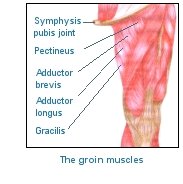
Many exercise and physical therapy experts have accused lactic acid of being the cause of a whole host of troubles. It causes pain and cramps, injures your muscles, leads to oxygen debt, etcetera, etcetera. But lactic acid has been given a "bad rap": it has its uses.
Lactic acid is the breakdown product of glucose and glycogen, produced during a process called glycolysis. The prefix “glyco” refers to the sugar glucose (glycogen is several glucose molecules bonded together and stored in muscle); “lysis” means splitting or breakdown. Essentially, lactic acid is a glucose molecule cut in half.
Glycolysis can proceed so quickly (as during weight training) that the formation of pyruvate far exceeds the capacity of the mitochondria to accept pyruvate into the Krebs cycle (which ultimately results in the aerobic formation of ATP, the primary form of cell energy). This excess pyruvate is converted to lactic acid.
The terms "lactic acid" and "lactate" are often used synonymously, even though they are different compounds: lactic acid formed through glycolysis releases a hydrogen ion to form lactate.
Does lactic acid cause muscle soreness?
The widespread belief that that lactic acid causes muscle soreness is a myth. Lactic acid has nothing to do with delayed-onset muscle soreness, the kind you feel 24–72 hours after strenuous exercise. That soreness is due to mechanical tearing of myofibrils during eccentric or lengthening contractions. If during your workout you had someone let the weight down for you on every negative or eccentric contraction so that you do just the positive or concentric reps, you wouldn't get sore.
Although concentric contractions don’t produce the damage and soreness that eccentric contractions do, concentric contractions produce more lactic acid.
Does massage help remove lactic acid?
Many massage therapists claim that one way massage helps your muscles recover is by the enhanced removal of lactic acid. There is also a persistent belief that a post-massage warm bath in Epsom salts will further rid your body of lactic acid. However, there is no evidence to prove that lactic-acid removal is enhanced by massages or warm baths.
What is known is that a drop in pH due to lactic acid accumulation in the muscle as a result of strenuous exercise can lead to a decrease in force production (the muscles get tired).
Will massage immediately after a workout help the recovery process? A study at the University of Northern Iowa compared the effects of massage, passive recovery and mild bicycle riding (about 40% of maximum oxygen uptake) on lactate metabolism after an exhaustive treadmill run. The subjects were trained runners who performed a maximal treadmill run to elevate the level of blood lactate and induce exhaustion after 4–6 minutes.
The subjects’ blood lactate was sampled for up to 20 minutes after exercise and researchers found that passive recovery (lying supine) and massage had no effect on blood lactate levels, while mild bicycle riding caused a better removal of blood lactate 15–20 minutes after exhaustive exercise. This suggests that the benefits of massage are unrelated to lactic acid removal.
Does lactic acid, have any benefits?
The accumulation of lactic acid during exercise can interfere with muscle contraction, nerve conduction and energy production, leading to acute fatigue - one reason why you tire during exercise. Yet lactic acid isn’t merely a useless byproduct of energy metabolism — it’s an important energy source.
The glucose paradox hypothesis suggests that when you ingest dietary carbohydrate, instead of it entering the liver and being converted to glycogen, it may in fact bypass the liver, enter the circulatory system and be converted to lactic acid (in tissues such as skeletal muscle). Consequently, the lactate produced returns to the circulatory system and is converted into glycogen in the liver. Alternatively, lactate can enter the general circulation where other tissues such as the heart, liver and kidneys can use it as fuel.
This backward path for liver glycogen formation occurs because lactate is removed much more rapidly from the circulatory system than glucose, which expedites the disposal of dietary carbohydrate without a tremendous insulin surge and stimulation of fat storage.
Lactic acid can also be used as an important fuel or as a source for glucose and glycogen synthesis. When you exercise intensely, for instance, lactic acid produced in your fast-twitch fibers can actually go to an adjacent slow-twitch fiber, which can then use it as fuel.
Approximately 75% of the lactic acid made during exercise is used as fuel. The remaining 25% is converted to glucose in the kidney and liver. The removal of accumulated lactic acid helps avert excessively high levels, and the conversion of lactate into glucose helps maintain sufficient levels of blood glucose, which is important during prolonged exercise.
In addition, even your inactive muscles play a role in muscle recovery. When you work one set of muscles (such as your legs) your inactive muscles (such as your biceps) can release lactic acid from their glycogen stores. This lactic acid travels to the liver via the bloodstream, where it’s converted to glucose. This glucose is shuttled back via the blood to the previously active muscles and serves as a substrate for glycogen resynthesis.
An important metabolic regulator
Since lactic acid is half the size of glucose, it crosses cell membranes more easily. Unlike glucose, which requires insulin for its transport across the cell membrane, lactic acid needs no hormonal support and crosses the membrane via facilitated transport. Also, muscles can release large quantities of lactic acid into the general circulation, where it can serve as a potential fuel source and precursor for gluconeogenesis.
So the next time a so-called expert bad-mouths lactic acid, remember that it has its merits.
Other related articles:
Other related articles:
Painkillers (Paracetamol)
Non-steroidal anti-inflammatory drugs (NSAIDs)
COX-2 specific inhibitors
Different Steroids
Cortisone injections




 Publications
Publications
 Partners
Partners










